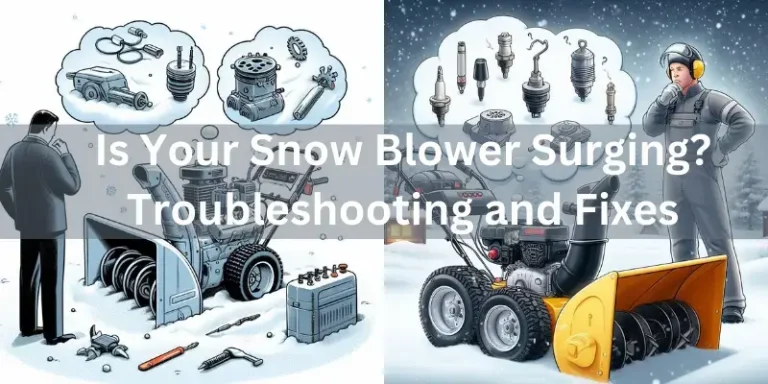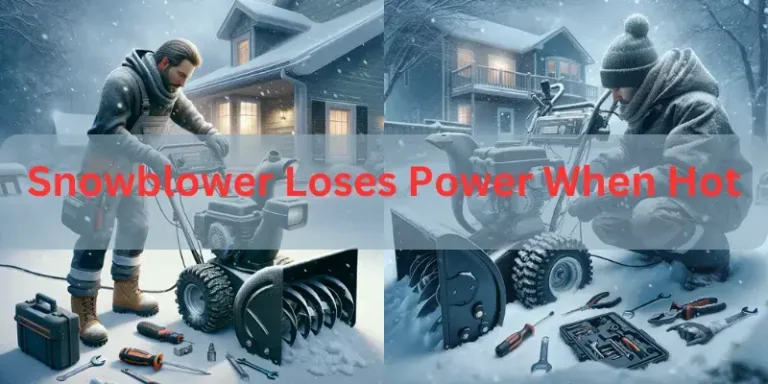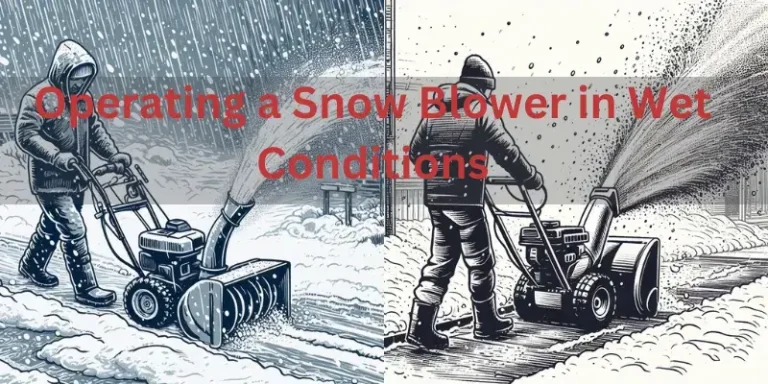Should I run my snowblower out of gas?
The question “should i run my snowblower out of gas” or whether to run a snowblower out of gas before storing it arises frequently among owners, especially during extended periods of non-use like the off-season. This practice involves intentionally depleting all fuel from the snowblower’s tank as a precautionary measure against potential issues stemming from stale fuel, which can degrade over time, causing engine complications such as difficulty starting or poor performance.
However, there’s debate among experts regarding the efficacy of this method, with some advocating for the use of fuel stabilizers instead to mitigate fuel degradation and corrosion risks. Ultimately, the decision hinges on various factors including manufacturer recommendations, storage duration, and individual preferences.
Consulting the owner’s manual or seeking guidance from a qualified technician can offer tailored advice pertinent to the specific snowblower model in question. Let’s discuss in detail in this guide. Keep reading…!
How to Store Your Snow Blower?
When winter is over and the snow starts to melt away, it is time to put your snowblower to rest until the next snowy season. Properly storing it ensures that when the snow comes back, your snowblower will be ready to go without any problems. Here is a simple guide to make sure your snowblower sleeps well during its break:
Fuel:
You can drain the fuel as recommended in your manual. This gets rid of the fuel and helps prevent issues like clogging and damage.
If you cannot drain the fuel, add a special liquid called fuel stabilizer and run the engine for a bit. This helps keep the fuel fresh, but you will need to refresh the stabilizer regularly.
Cleaning and Protection:
Wash the snowblower with mild soap and water to remove dirt and salt. Dry it well to stop rust. Put some oil on moving parts like the joints, wheels, and gears to keep them working smoothly. Use a special spray to protect metal parts from rust and moisture.
Maintenance:
Change the oil to keep the engine in good shape during storage. Check your manual for the right oil and how often to change it. Look over parts like belts, hoses, and spark plugs to see if they’re worn out. Replace anything that needs it to make sure your snowblower works well next winter. Check the tire pressure and fill them up as needed. This prevents flat spots and helps the snowblower handle well.
Storage:
Keep your snowblower in a cool, dry place like a garage or shed. Avoid leaving it outside where the weather can damage it. Raise it off the ground with blocks or a stand to prevent flat tires and moisture buildup. Cover it with a special cover to keep out dust, dirt, and pests.
By following these steps, you will make sure your snowblower is in great shape and ready to tackle the snow when winter comes back around. And always check your manual for specific instructions for your snowblower model.
Should I Run my Snowblower out of Gas?
Whether you need to drain the fuel from your snow blower before storage depends on the type of fuel you’ve been using. If you’ve used fuel stabilizer, just top off your snow blower’s fuel tank before storing it to prevent water buildup and keep the fuel from getting bad. But if you have used regular gas from the pump, it is best to drain the fuel.
This helps avoid a corrosive mix forming in the tank that can clog your snow blower’s carburetor and cause starting problems. You can use a gas siphon or a turkey baster to remove most of the gas, then run the snow blower until it’s empty. Another option is to top off the tank with gas and add stabilizer according to the instructions on the bottle before storing.
On the other hand, according to some experts, It’s actually not a good idea to completely run your snowblower out of gas before storing it. While it might seem like a simple solution to empty the fuel system, it can lead to more problems than it solves. Here’s why:
Running out of gas can cause issues such as:
Carburetor gumming:
When the fuel level gets low, air enters the system, causing the remaining gasoline to evaporate and leave behind sticky deposits in the carburetor or varnish inside the carburetor. These deposits can clog the small passages and jets within the carburetor, making it difficult for the engine to receive the correct mixture of air and fuel needed for combustion, thus hindering the starting process.
Damage to fuel lines:
When the fuel tank is completely emptied, creating air bubbles within the fuel lines. Over time, these air bubbles can cause the fuel lines to degrade, leading to cracks or leaks. This damage can compromise the fuel system’s integrity, potentially causing fuel leaks or interruptions in fuel delivery to the engine.
Difficulty restarting:
Getting the engine going again after it’s run dry can be a challenge, especially if the carburetor is gummed up. If the carburetor is gummed up with varnish deposits, as mentioned earlier, it can further impede the starting process.
Additionally, air bubbles in the fuel lines can disrupt the flow of fuel to the engine, making it harder to achieve proper combustion and restart the engine successfully. Overall, these factors contribute to the difficulty of restarting the engine and resuming normal operation of the snowblower.
Should I store my Snow Blower with Gas in it?
Storing a snowblower with gas means keeping the fuel system saturated with gas year-round, including the tanks, fuel lines, and carburetor, typically treated with a stabilizer to prevent fuel degradation.
Advocates argue that this method keeps the system lubricated and reduces the risk of varnish buildup or gasket damage. However, detractors caution that despite these benefits, certain parts may still dry out over time, necessitating periodic starting of the machine.
Additionally, there is no guarantee that the gas will remain in good condition even with stabilizer added, potentially leading to issues. Moreover, maintaining a snowblower with a full tank of gas can pose challenges during annual maintenance due to fuel leakage when the machine is tilted.
Expert Advice on Snowblower Storage:
Ariens: Store Without Gas
Ariens, a leading snow blower manufacturer, recommends completely draining the fuel system before storing your snow blower for the season to prevent potential issues.
Briggs and Stratton: Store With Gas
Briggs and Stratton suggest storing your snow blower with a full tank of gas treated with a stabilizer to protect against corrosion and minimize moisture accumulation.
Honda: Store Without Gas
Honda advises draining all gasoline from the fuel system, including the tank, to avoid problems associated with stale fuel during storage periods.
Sears: Either Option
Sears, a major department store, offers a flexible approach, allowing for either removing the gas or treating it with a stabilizer to prevent gum deposits.
Snow Blowers Direct: Store Without Gas
Snow Blowers Direct, a specialist snow blower outlet, recommends draining the tank at the end of the season to avoid issues with stale fuel.
Toro: Store Without Gas
Toro, a manufacturer of various snow blower models, suggests emptying the fuel system by running the engine dry as a precautionary measure during storage.
Frequently Asked Questions (FAQs)
How long can fuel sit in a snowblower?
Untreated fuel can last up to 30 days, but it quickly degrades, forming varnish deposits within this timeframe, potentially clogging the carburetor and causing starting issues. Fuel treated with stabilizer can extend its lifespan to up to 2 years, although the effectiveness depends on the type and quality of the stabilizer used. Despite this, it is advisable to use treated fuel within a year to maintain optimal performance.
Should you run a snowblower dry?
Running a snowblower dry is not advisable as it can lead to various issues. It can gum up the carburetor, damage fuel lines, and make restarting difficult due to the formation of sticky deposits and air bubbles in the system.
Is it better to drain gas or use a stabilizer?
Draining the fuel is the safest way to prepare your snowblower for storage, eliminating the risk of damage to the fuel system. If draining isn’t possible, using a high-quality fuel stabilizer is recommended, following dosage instructions carefully. Regardless of the method chosen, running the engine after adding stabilizer and storing the snowblower in a cool, dry place are essential steps for ensuring smooth performance when needed.
My Final Thoughts:
Whether you should run your snowblower out of gas before storing it depends on various factors, such as the type of fuel used and personal preferences. Adding a fuel stabilizer can extend the lifespan of the fuel and mitigate potential issues, while draining the fuel entirely eliminates the risk of fuel degradation and damage to the system.
Consulting the owner’s manual or seeking guidance from experts can provide tailored advice for your specific snowblower model. Proper storage practices, including cleaning, maintenance, and choosing the right fuel storage method, are essential for ensuring your snowblower remains in good condition and ready for use when needed.

About Naveed A Hashmi
In my childhood, I used to see my parents while working in the land, for these reasons today I have been serving the same as our own tradition and culture. I thus love to stay in it, because I want to learn something advanced and new so that I may improve my farm’s contour and help others with my experience.







